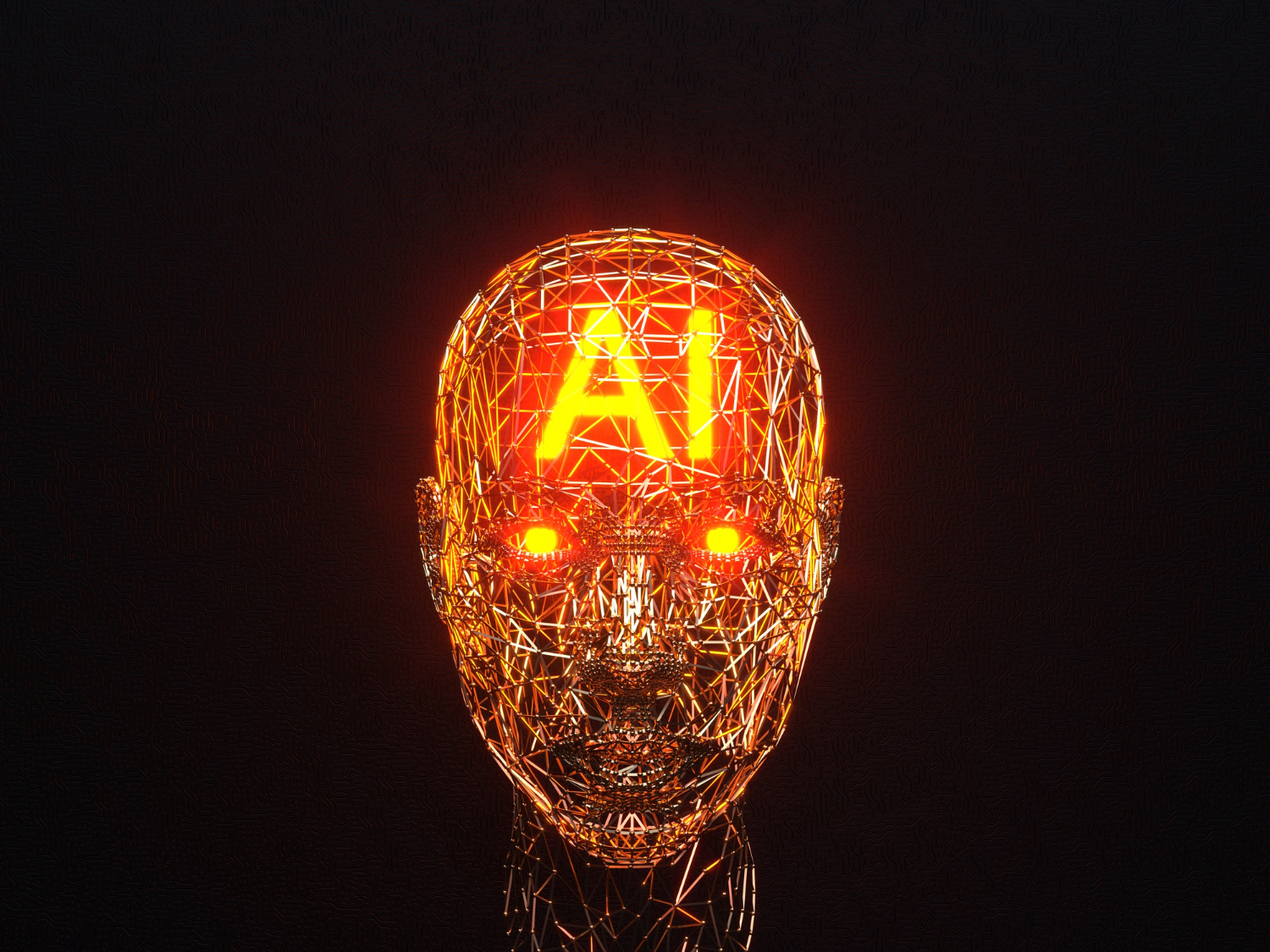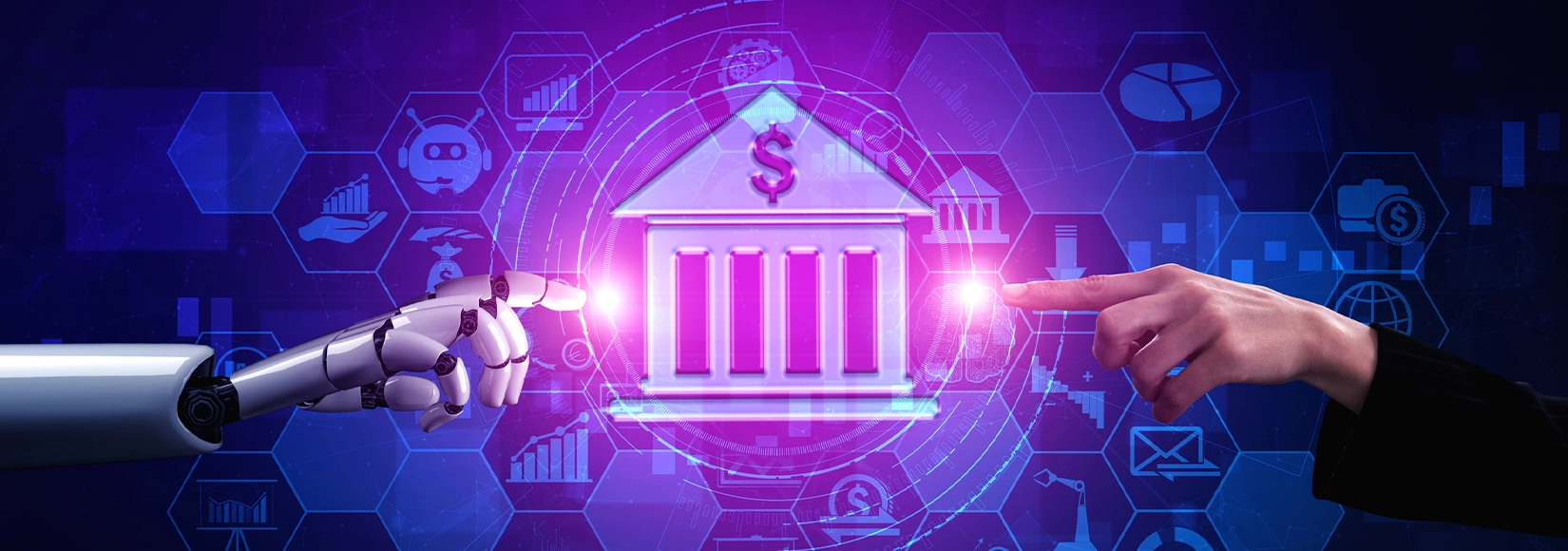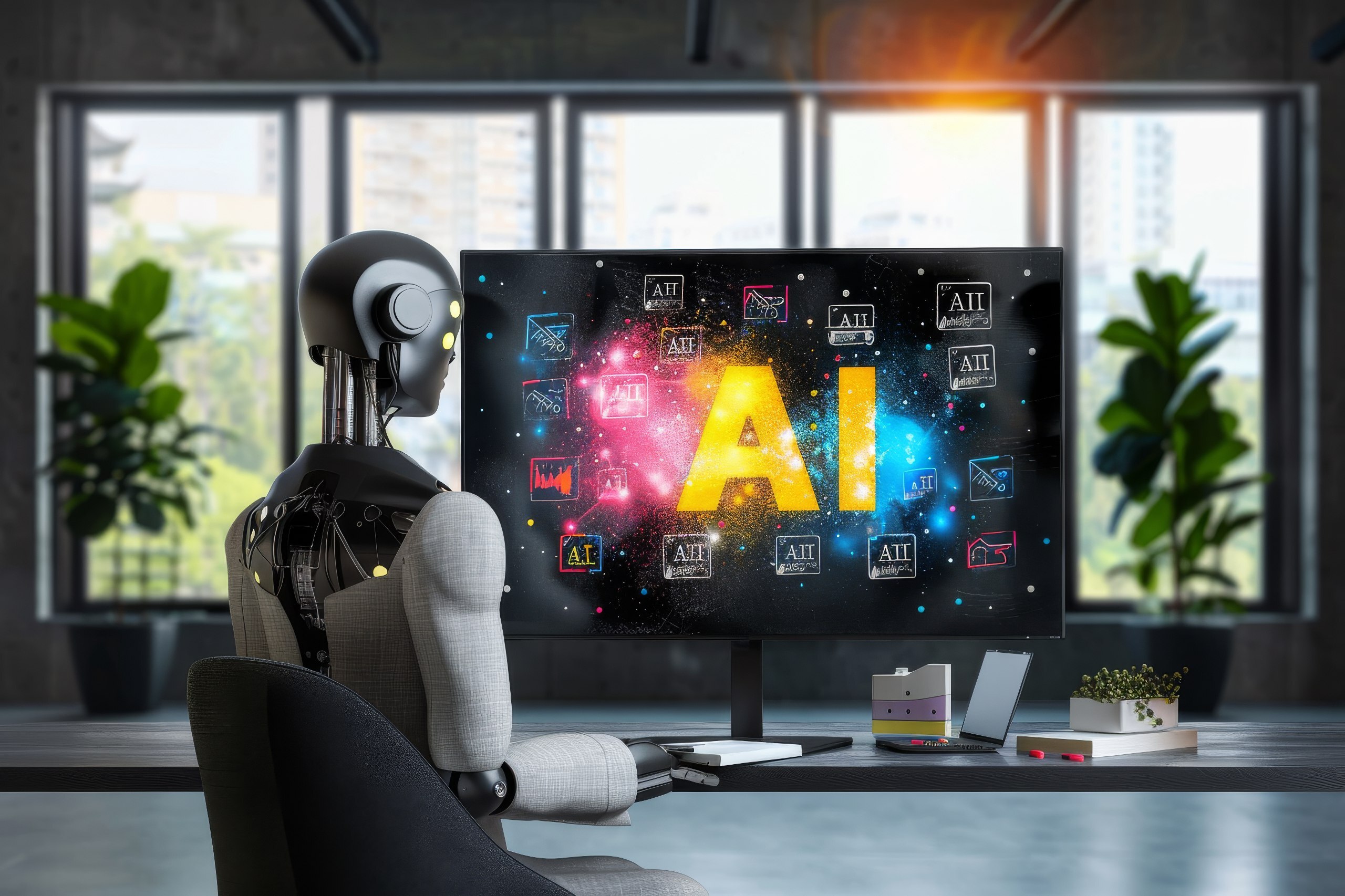Artificial intelligence and blockchain are the two technologies that have gained the most popularity in the last few years.
The global attention that was put on blockchain technology backed cryptocurrencies in the post-pandemic era skyrocketed their utilization and brought numerous supporters. While the crypto hype is still up, excitement has also built up for the advancing field of artificial intelligence. Many labeled the two technologies as rivals for global attention and capital. However, the truth is something else.
Blockchain and AI are two different growth paths, and many upcoming projects are working on combining the two to utilize the decentralization benefits along with the efficiency of AI models.
In this blog, we will talk about decentralized physical infrastructure networks, DePIN in AI, the world where AI and blockchain combine.
What is DePIN?
DePIN, or Decentralized Physical Infrastructure Networks, uses blockchain technology to develop, maintain, and operate physical infrastructure in the real world across various fields like transportation, energy, and wireless connectivity. They use token rewards to incentivize buildings in the physical world. Today, DePIN is also being used in the AI industry to serve AI needs like data storage and GPU computing.
A widely seen example of DePIN is Uber. Uber drivers use vehicles (physical infrastructure) and offer services like car rides (chauffeuring) and get paid by the customers for these services while the platform makes these services accessible to large users.
For DePIN, blockchain basically works as an administrative and record-keeping facility that stores information about the decentralized physical infrastructure (like vehicles), offering users to have permissionless access to these services, allowing them to utilize them as long as they have enough resources like money, time, etc.
Types of DePIN
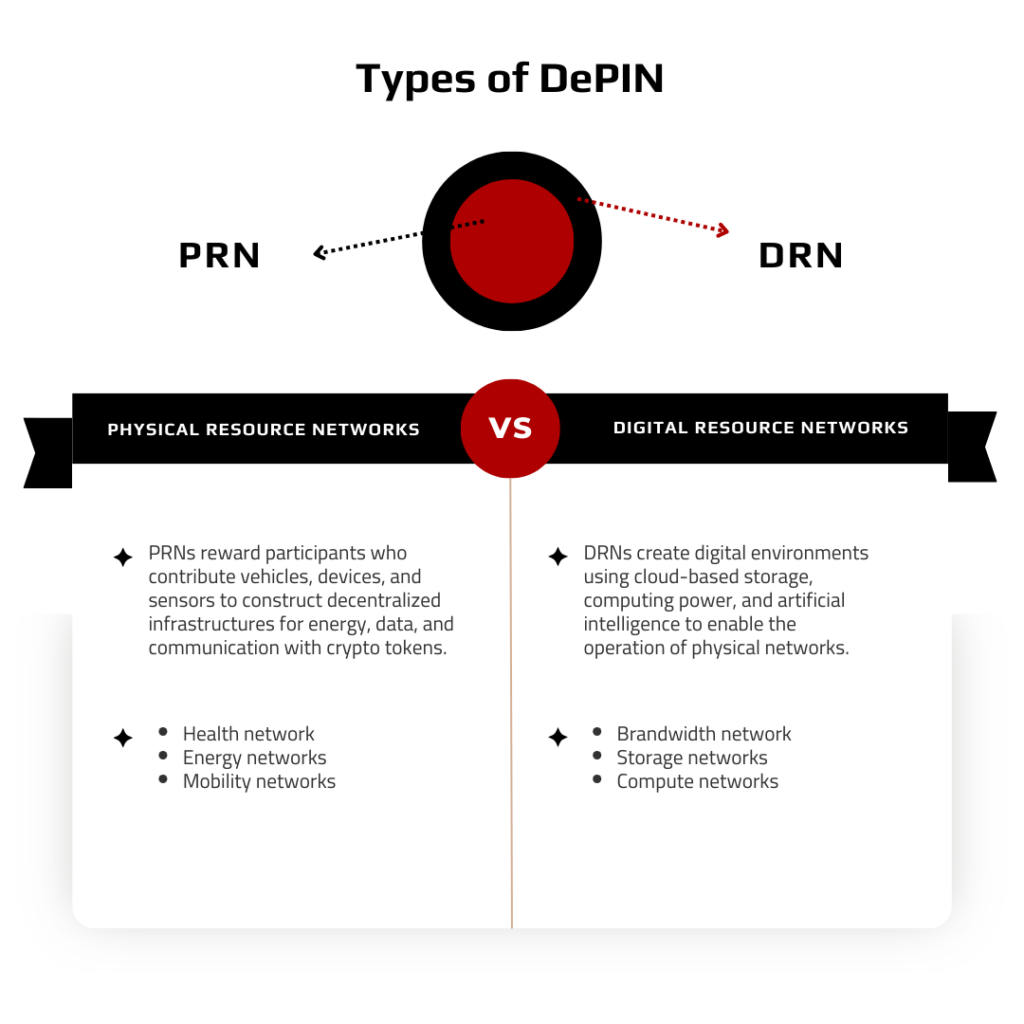
DePIN is broadly categorized into two categories: Physical Resource Networks (PRNs) and Digital Resource Networks (DRNs). According to the Messari Report, both PRNs and DRNs are characterized by the resources, hardware, goods, and services they offer.
Physical Resource Networks (PRNs)
Physical resource networks offer crypto tokens to participants that deploy their physical resources like vehicles, devices, and sensors to build decentralized infrastructures for energy, data, and communication.
PRNs are in the middle of technologies like Web3, blockchain, artificial intelligence, and physical hardware that allow users to utilize the created network and devices worldwide.
Digital Resource Networks (DRNs)
DRNs provide digital spaces through cloud-based storage, computing power, and artificial intelligence where physical networks can operate.
Using cloud infrastructure at the backend, DRNs offer cryptographic tokens as incentives to people to support location-independent digital tokens, such as bandwidth, storage, and computing power. All the transactions are recorded in blockchain ledgers to oversee the network. Moreover, it is easier to exchange digital resource networks (DRNs) than physical resource networks (PRNs).
How does DePIN work?
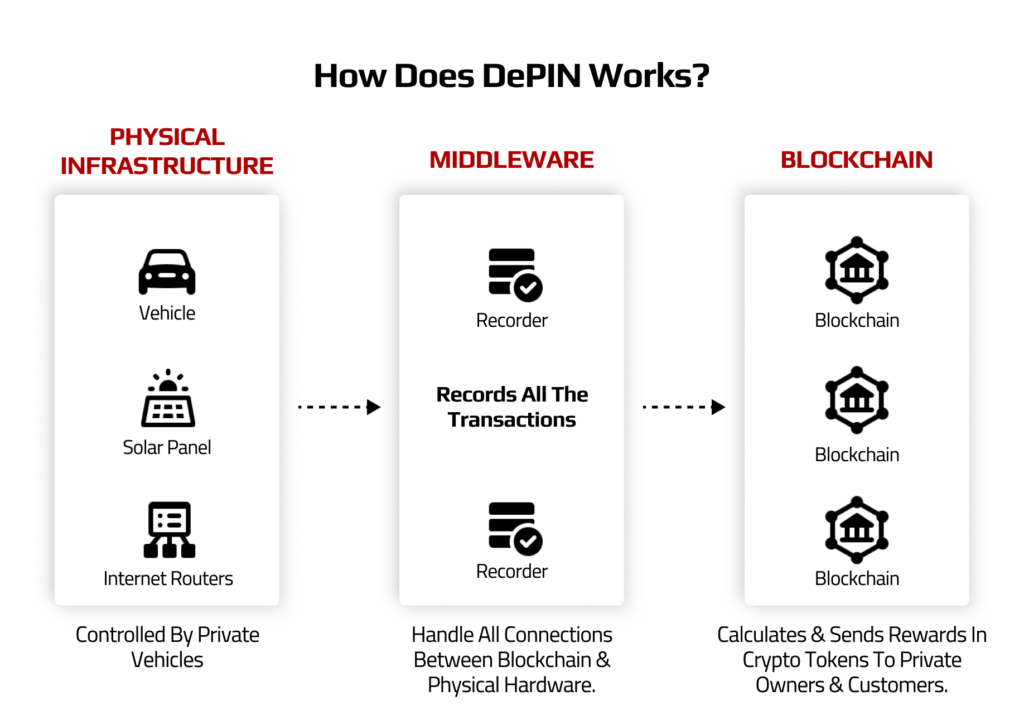
DePIN creates a network between the service provider providing facilities through physical infrastructure, and a middleware could be a digital platform like web applications that connects the physical infrastructure to the blockchain that stores all the information in a public ledger.
Let’s take an example of a decentralized cab service platform. In this case, our physical infrastructure is a cab or car that is offered by various private owners. Now, due to a decentralized network, the cab providers can directly connect to the riders in a transparent and cost-effective manner. Further, through a middleware, all this data, including the events in the process, like rider booking the cab, cost of the ride, distance, etc., would be recorded in a public ledger offered by a blockchain network.
To dive even deeper, let’s discuss the involved components in detail:
Physical Infrastructure:
From vehicles, solar panels, sensors, and internet routers, physical infrastructure can be anything that would offer service to individuals. All the physical entities would be controlled by a private provider, which may own them even before the participation. Moreover, there can be as many private providers as possible who want to participate in the decentralized physical infrastructure network and offer their services. All the private providers, pre-existing or newly engaged, would fuel the DePIN’s initiative, amplifying the network and contributing to its resilience and diversity.
Middleware
Middleware handles all the connections between the blockchain and the physical hardware. It helps record all the transactions and data on activities of each of the physical hardware providing services and transfers it to the DePIN network. Just as a decentralized oracle network collects data from the outside and transmits it into the blockchain platform, middleware works in the similar fashion.
Blockchain
After middleware delivers the recorded information to the blockchain system, the blockchain acts as an administrator and remittance system for the private owners and customers. On the basis of activities, the blockchain calculates the rewards and sends them in cryptocurrencies or tokens. For customers, blockchain acts as the sourcing of resources, including setting prices within the payment system, where users are kept transparent with the payment information and are charged right away for the resources they use.
Therefore, using all the components, a growing and resource-efficient physical infrastructure is created using incentivization, where private providers are given rewards to deploy their physical hardware for providing a certain service to the customers. These rewards motivate a high number of private providers to offer their services. Further, the DePIN network makes these services accessible to the users. Decentralization offers resource procurement and, most importantly, reduced prices that attract a lot of customers or users. Thus, the revenue is generated through the fees that users pay. As the network grows, the value of tokens also shoots high, which leads to a higher attraction of investors and providers to the business.
Thus, this trending technology, a decentralized physical infrastructure network, offers nothing but growth.
How DePIN in AI can influence current dynamics?
Now, what happens if we integrate the decentralized physical infrastructure network(DePIN) into the AI systems? This basically means that the AI systems shall be trained using a distributed dataset instead of the centralized data available. To understand how DePIN in AI can be helpful, let us break it down into key points:
Data Privacy
By incorporating distributed data storage technology and preventing unauthorized access to sensitive information, DePIN in AI helps in building transparent and privacy-respecting platforms that reduce the risk of data breaches and build a trustworthy connection between users and service providers. Hence, using DePIN, information can be kept safe and secure, and individuals or data generation bodies would have greater control over their sensitive data.
Distributed Data Ownership
DePIN lets individuals retain ownership and control over their data. Unlike centralized systems of storing data, this decentralized approach allows people to decide how their data and personal information would be utilized. Hence, the control access that DePIN offers gains people’s trust and lets them share their crucial data for various data-sharing purposes which also accelerates the development of decentralized AI systems.
Innovation and Collaboration
DePIN fosters collaboration between different institutions by allowing controlled access and data sharing among the stakeholders. In artificial intelligence, DePIN allows the use of distributed and controlled datasets for the training and development of AI models without compromising data privacy and security. Thus, this democratization of data triggers AI innovation while maintaining sovereignty over the sensitive information of data owners.
Regulatory Compliance
With the tightening of data privacy laws such as the GDPR in Europe and the CCPA in California, the need for businesses and organizations to adhere to these regulations has intensified. The implementation of DePIN in AI offers a strategy to align with these legal standards while still utilizing data for AI development. Decentralized systems inherently support regulatory compliance by reducing the accumulation and vulnerability of personal information.
Redistribution of Economic Value
In centralized systems, revenue is generated by monetizing the data of users or individuals and kept undistributed for the central body. In decentralized systems, the economic value generated from data-driven services and applications is distributed among the data contributors, be it individuals, small organizations, and service providers like private owners. Hence, decentralization allows a fairer way of distributing revenue, inclusive of the digital economy where data contributors are also rewarded for their contributions.
Therefore, the utilization of DePIN in AI prioritizes data privacy, security, collaboration, and regulations, which further build trust and accountability that accelerates the growth and innovation of artificial intelligence.
Use Case of DePIN in AI
An instance of a case in which decentralized physical infrastructure network is used in AI is healthcare data management.
In this scenario, healthcare providers and patients generate huge amounts of medical data that would be possibly used for patient’s treatment, research, record-keeping, and medical discoveries. Traditional centralized systems used for storing and processing sensitive medical data raise concerns about data privacy, security, and control over personal information. With DePIN, we can cut off these problems by decentralizing the control over this data. By integrating the DePIN technology into AI, AI models will be trained using distributed datasets without needing sensitive information to be stored in a centralized platform.
Suppose hospitals, research institutions, and clinics collaborate with each other for a research project on “Diagnosing Diseases through AI”. In such a case, instead of having to share the raw patient data with a central entity, DePIN technology will allow all the above participants to have control over the sensitive information. This way, the AI model would be trained using this distributed data set to diagnose the diseases accurately while upholding the safety of the personal information of patients and protecting the same from any unauthorized access.
In this way, sensitive medical information would be kept safe under the control of the institutions or owners that generate the data while also using the data for the collaborative development of the AI model, which could benefit society in a certain way.
Thus, the approach of using DePIN in AI helps in bringing advancements in the technology, builds trust and accountability for AI solutions and prioritizes data security, privacy, and authorized access for social welfare.
Infrastructure for DePIN-AI
The rise of Decentralized Physical Infrastructure Networks (DePIN) has surpassed traditional AI development that relied on centralized resources by advocating for distributed and collaborative data management. A resilient infrastructure is important to leverage the potential of DePIN in AI. The following are some key components:
Decentralized Compute Power
Harnessing edge computing and distributed networks to enable the processing of AI systems inclined towards the physical infrastructure, thereby enhancing efficiency and reducing latency in DePIN AI platforms. For example, the term “Distributed Processing Networks- DPN” instead of GPU (Graphical Processing Units) to refer that various processors being used instead of just one GPU, establishing a widely distributed platform for AI computations.
Decentralized Data Storage Solutions:
Platforms like IPFS, Holochain, and Holo make use of blockchain-based networks to enable secure and distributed storage of infrastructure data, reducing the dependency on centralized repositories. Also the platforms Filecoin and Sia are blockchain-based distributed file systems that are used to store massive datasets for AI training.
Decentralized Data Sharing and Collaboration Mechanisms:
Decentralized Autonomous Organizations (DAOs) play a pivotal role in promoting collaborations and governance in data collection, curation, and model training within a decentralized AI (DeAI) ecosystem. In such an environment, participants can vote on decisions related to data access, updation, or model development that ensure security and transparency among them.
Decentralized AI Models and Applications:
The distribution of model training across various nodes within DePIN networks is cultivating an environment that fosters collaboration and innovation, particularly in the application of AI for managing physical infrastructure. This distributed AI model not only enhances computational efficiency but also leverages diverse datasets across nodes, leading to more robust and innovative solutions in physical infrastructure management.
Community-Driven Development of DePIN AI Frameworks:
Community-driven frameworks like OpenAI Gym or TensorFlow exist as open-source platforms that could be utilized for DeAI model development to empower developers to create interoperable and efficient AI solutions that stimulate innovation and inclusivity in decentralized physical infrastructure networks.
So, by adapting robust infrastructure for DePIN in AI, the potential of a decentralized physical infrastructure network can be unlocked while boosting efficiency, resilience, and sustainability while advancing the capabilities of AI to manage critical infrastructure assets.
Benefits of DePIN in AI
Cryptocurrencies and blockchains are peculiar due to their decentralized nature, which offers transparency, privacy, security, immutability, and control of access to information. Combining these characteristics with the revolutionary potential of AI turns technology into a disruptive and powerful force.
Permissionless Access:
In the computing market, with the coming of artificial intelligence, the popularity of GPU chips has become difficult and expensive to acquire.
Users who rely on centralized cloud computing providers for on-demand computing services may require permission to access them, as high-performance GPU units are reserved for the largest customers. On the other hand, DePIN provides permissionless access to GPU power or other high-performance computing resources which solves this major problem for many.
Use Of Decentralized Data Storage Networks:
Unlike centralized systems that always raise questions on data privacy and security, when data is stored in decentralized data storage networks, it gets stored across the global network of nodes, which makes it immutable transparent and also eliminates the risk of data loss and data breach. Therefore, decentralized storage systems ensure data safety, security and maintain its integrity.
Boost In AI Development:
By integrating DePIN technology into AI systems, AI models operate in a distributed and open-source manner. Also, the AI algorithm gets trained using a distributed data set, which also aligns with data integrity and security and allows institutions to participate in data-sharing initiatives, providing access to more reliable data for AI model training. All of this would add innovation and enhance the accuracy of AI systems. Moreover, the integration of DePIN would reduce entry barriers, allow permissionless access without the fear of data breaches, and make AI solutions more affordable and cost-effective.
Challenges of DePIN in AI
While DePIN has the potential to revolutionize the world of artificial intelligence by accelerating innovative, secure, and collaborative development, it does come with certain challenges discussed ahead.
The first challenge is regarding Data and IP Verification. DePIN operates on distributed networks which makes it difficult to verify the ownership and the source of data being used to train AI algorithms. Using unverified data can also lead to problems like biases, inaccuracy, and copyright infringement in the dataset used.
The second challenge arises with Scalability and Complexity. The safety, cost-effectiveness, and unique features that this combined technology of DePIN and AI offers attract large numbers of participants and users, which makes the network quite hefty. Managing this complexity while upholding efficiency is another struggle.
At last, Regulation becomes a hurdle. The fast-paced nature of AI technology and DePIN poses challenges for regulators. Developing clear frameworks that ensure the responsible use and development of DePIN-AI systems is important.
Future of DePIN in AI
As advancements happen in decentralized physical infrastructure networks and artificial intelligence, we can expect many more innovative solutions relating to incentivized infrastructure like Web3 smart cities and decentralized networks in various domains like security, healthcare, logistics, manufacturing, etc.
At last, as the domains of DePIN and AI expand, the potential use cases go beyond theoretical discussions. This dynamic collaboration stands for more than just integration. It is a total paradigm shift towards the era where decentralized AI is the only reality. This is just the beginning of a transformative reality where the fusion of these two revolutionary technologies opens new doors for innovation, accessibility, and equitable technological solutions.
Looking for the best AI development, integration, and consulting company? Look no further because Build Future AI has it all!

